|
| |
Back to Transports
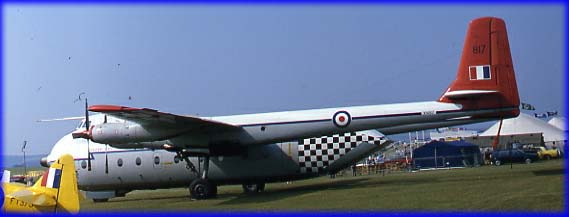 |
The Armstrong Whitworth Argosy was designed
in the 1950s as a heavy transport for the Royal Air Force. It
adopted the same general layout as the American Fairchild C-119,
having twin tail booms to give an unobstructed loading and unloading
area, ideal for paratrooping and for loading armoured vehicles. The
flight deck was raised to increase freight capacity, which
nonetheless was small (14.5 tons compared with the C-130's 37 tons).
The increased drag made it quite slow (280mph compared with 350mph
for long range cruise), and the range limited (1,760 miles compared
with 2,370 for the C-130). It was powered by four Rolls-Royce Dart
turboprops. Not surprisingly it was replaced by the C-130 in RAF
service, but not before this one was photographed at Middle Wallop
in July 1984. |
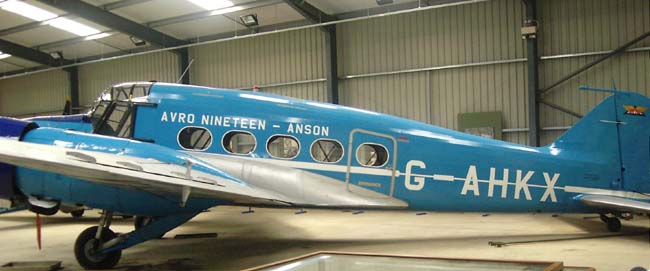 |
More than 11,000 Avro Ansons were built,
mainly during the second world war. Originally designed in 1935 as a
light transport, they served in this role in the Air Force but were
also adapted for light bombing, gunnery training and a host of other
specialised applications. Ansons appeared with a variety of
configurations of side windows, and some had gun turrets, but all
were powered by two Armstrong Siddeeley Cheetah radial engines of
around 300hp each. Cruising speed was about 165mph, range 790 miles,
and typical capacity was for 8 passengers plus two crew.
This one is preserved in the museum at Old
Warden, where it was pictured in April 2005. Photograph by Ivy |
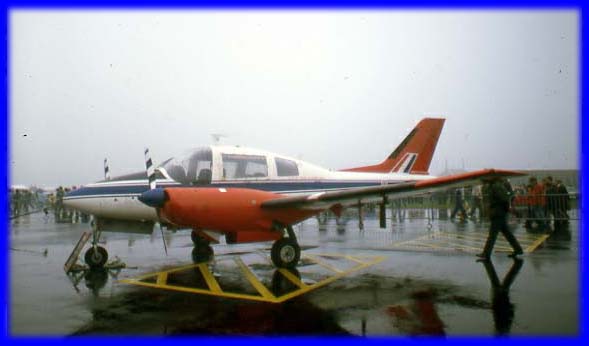 |
The Beagle 206 Bassett was a powerful and elegant
twin engined light transport which could take up to seven
passengers. It was used by the RAF as a communications aircraft.
Performance for a piston twin was very respectable; it cruised at
250mph and had a range of 1,800 miles. They were, however, expensive
to maintain so had a relatively short service life.
This one had been used as the personal
aircraft for the Prince of Wales, and was at Finningley in September
1980. |
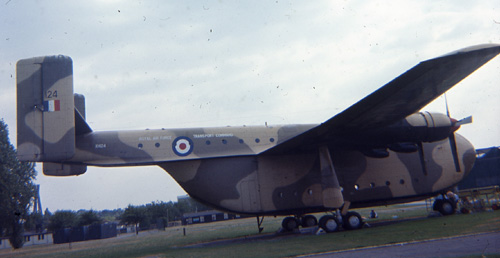 |
The Blackburn Beverley was a huge double deck
four engined transport which first flew in June 1949. Emphasis was
on simplicity, hence the fixed undercarriage, which also limited its
speed to 240mph despite its whopping 2,850hp Bristol Centaurus
engines. Range was a respectable 1,300 miles. Maximum weight was
139,000lb; it could carry 80 troops on the upper deck and some
40,000lb of cargo in the main hold (depending on the amount of fuel
carried). It is 100 feet long with a wing span of over 160 feet, but
most imposingly is 40 feet tall. 49 were built.
One was at an airfield in the Middle East, when a
US transport landed. The American pilot came over and asked if this
was the `largest aircraft the British had out here'. `Yes', came the
reply, `but you ought to have seen the one we flew it out here in!'
This one was preserved at Hendon, and was
pictured in August 1975, but sadly suffered from severe corrosion
and no longer exists. |
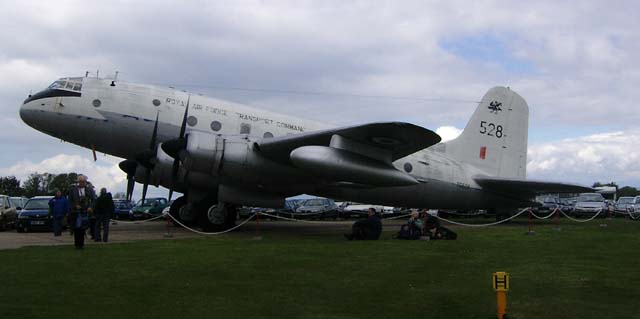 |
The Handley Page Hastings first flew in May
1946, the design having been prepared but not built during the
second world war. It is a large four engined transport, powered by
four Bristol Hercules radial engines of 1,650hp each. Surprisingly
for its size it only carried 50 people. It cruised at 350mph and had
a range of over 3,200 miles. About 150 were built, exclusively for
the RAF. They were still in use (as bomber trainers) into the late
1970s, being a regular sight flying up the East coast from their
base in Lincolnshire. This one is
preserved at Duxford and was seen there in May 2005. |
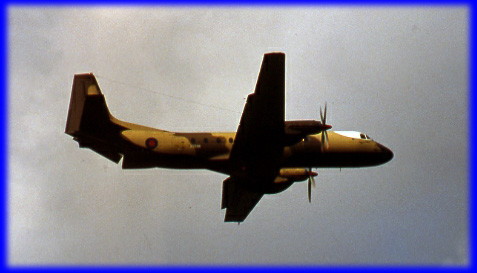 |
The Hawker Siddeley Andover was a military
version of the HS748 airliner, built specially for the RAF. It
differed from the civil version in having an upswept rear fuselage
with loading ramp for vehicles, a taller tail for stability when
flying with the ramp open, and a `kneeling' undercarriage to
facilitate loading - an innovation since copied by some other cargo
aircraft. Its main drawback was its relatively limited capacity. It
fell victim to a desire to reduce the number of types in RAF
service, and was effectively replaced by more Hercules.
This one was flying past at Abingdon in
September 1983. |
 |
The Percival Sea Prince was designed by
prolific designer Edgar Percival shortly after the end of the second
world war. It was a development of the smaller Percival Merganser
civil transport, specifically customised for the Royal Navy. It was,
however, not operated from ships, but used as a transport to ferry
people and stores between ports.
This one was at Greenham Common in July 1983. |
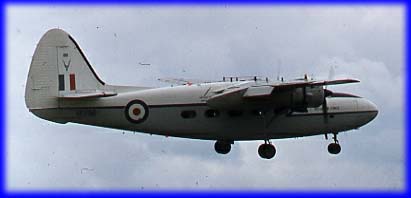 |
The Percival Pembroke was a further
development of the Prince / Sea Prince range, used by the Royal Air
Force. It was built from 1953 and served in considerable numbers
until the early 1980s. Its Alvis Leonides radial engines developed
550 horsepower each, and hauled the Pembroke for over 1,000 miles at
between 160 and 200 mph. Normal seating was for between 10 and 12
plus crew. This one, operated by 60
Squadron at Wildenrath, Germany, was seen landing Fairoaks in August
1980 |
|
|
These very poor photographs are the only ones
I have of the Short Belfast. The top one shows two RAF Belfasts in
the background behind a Transamerica Lockheed Hercules. The lower
shows a former RAF aircraft, operated by Transmeridian Air Cargo
before it changed its name to HeavyLift.
The Belfast was one of the heaviest transports
of its day. It first flew in 1964. It could carry 14 tons of cargo
for 4,000 miles at 340mph. It was powered by four Rolls-Royce Tyne
engines - a development of the engine powering the Vickers Vanguard.
Only ten were built; the RAF retired them in 1976, and they flew
commercially until the mid 1990s.
Flying the Belfast demanded some quite
specific skills, because there was a substantial time-lag between
operating the controls and anything actually happening! The cause
was the response time of the power operated control surfaces.
Despite this idiosyncracy, no Belfast was ever involved in an
accident in service. |
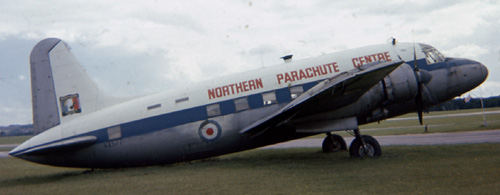 |
The Vickers Valetta, which first flew in June
1947, was essentially a military version of the civil Viking and a
direct descendant of the wartime Wellington bomber (but with a
simpler, all metal fuselage). Powered by two 1,975hp Bristol
Hercules engines, it could fly at 260mph for a range of 1,450 miles.
It was about 63 feet long, with a wing span of just under 90 feet.
This one was at
Sunderland in September 1974. For a long time it did not fly, then
was taken on by the Sunderland aircraft museum. They had to move it,
and wondered if they could taxi it under its own power. So they
tried starting the engines. After several years of idleness, they
were amazed to find the first engine started straight away. But not
half so amazed as several starlings, which flew out of the engine
compartment in extreme surprise and annoyance! |





|